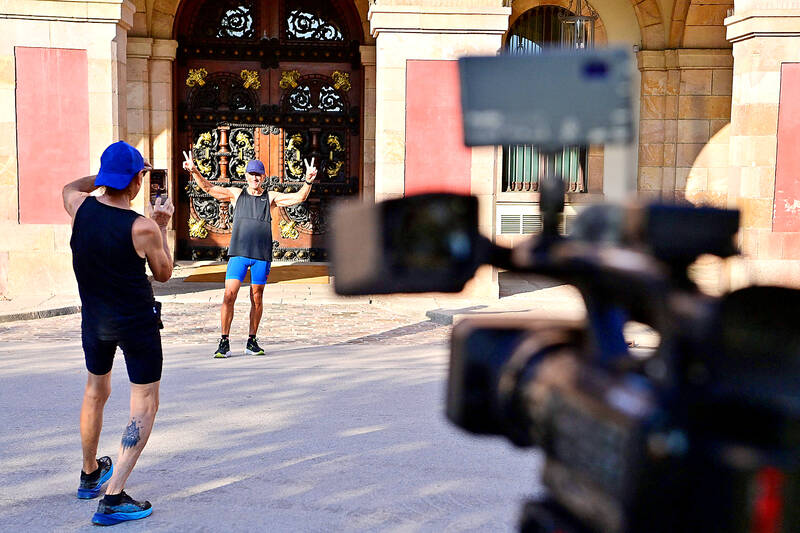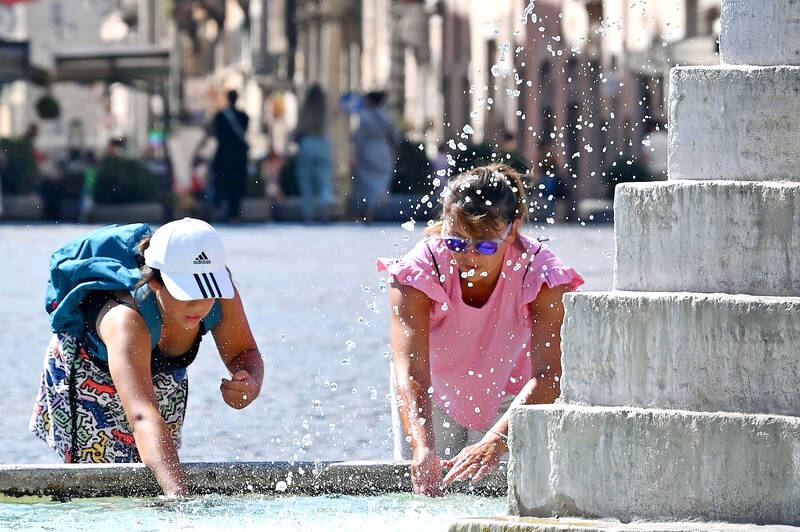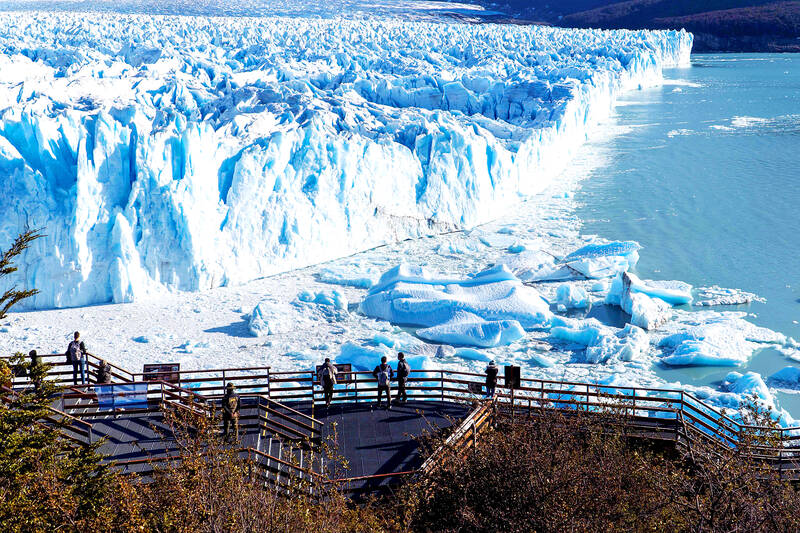Tourism has never had a great reputation, given that the very word “tourist” is pejorative. At best, it suggests someone whose interest is superficial and whose understanding of a place is nonexistent. What’s the first thing you think, when you hear the phrase, “They’re a bit of a tourist”? You think, that person is annoying. But the word’s reputation has plummeted further in recent years. Anti-tourism movements are springing up across the world: that might look like a protest march, as in Barcelona, where one placard bluntly pleaded “Tourists go home; you are not welcome here.” It might look like a visitor fee, as Venice introduced this year, or it might look like the mayor of Amsterdam simply closing the cruise ship terminal, as she did last year.
TOURISTS ‘STAY AWAY’
Part of this is about sheer volume: the number of people crossing an international border as tourists (rather than displaced people or migrants) last year was 1.3 billion, which is not only a complete bounceback post-COVID, but an almost 25-fold increase since the 1950s. Driven not only by flights becoming ever more affordable, but the online convenience of booking travel — from the launch of last-minute flight and hotel brokers in the late 90s, to Airbnb in the late 00s, followed by Google Flights and Trips — everything about travel has become easier and cheaper. But the difficulties and costs still exist, they’re just paid elsewhere. Tourism accounts for just over 8 percent of all global greenhouse gas emissions. Short-term holiday rentals distort housing markets until the locals are spending summer months living in car parks — as has happened in Ibiza.

Photo: AFP
And that’s just the aggregate impact of tourism, before any of us have arrived and started doing anything. Dubrovnik in Croatia has new rules about not jumping in fountains or climbing on statues and not walking around shirtless. Amsterdam launched a “stay away” advertising campaign (specifically aimed at the British, shamingly). Budapest, Munich, Dusseldorf and Prague all banned “beer-bikes,” those 17-seat charabancs where stag parties pedal their way to oblivion. Split has introduced specific fines for vomiting and urinating in public (again, those signs are in English). The Italian culture minister, meanwhile, has simply had enough of people defacing the Colosseum.
When you look at anti-tourism movements as a whole, it’s hard to escape the conclusion that travel is one of those nice things we no longer deserve. But into that sorry picture steps the travel journalist Paige McClanahan with her book The New Tourist. We can still travel, she says, and more than that, it’s important that we do; we just have to get a lot better at it.
The old kind of tourist, she writes, is “a pure consumer who sees the people and places he encounters when he travels as nothing more than a means to some self-serving end: an item crossed off a bucket list, a fun shot for his Instagram grid, one more thing to brag about to his peers.”

Photo: AFP
The new tourist, by contrast, is humbled by the unfamiliar, not unsettled by it, she “embraces the chance to encounter people whose backgrounds are very different to her own, and to learn from cultures or religions that she might otherwise fear or regard with contempt.”
Maybe that doesn’t sound groundbreaking — in brief, when you’re away, try being your best self — but it cuts to the heart of a book that is part a modern history of international travel, part manifesto for it.
Fundamentally, McClanahan sees travel as a social good. “When we think about the challenges humanity is going to face in the years and decades to come, whether it’s another pandemic, runaway AI or catastrophic climate change, each of these crises is completely ignorant of national borders,” she says. “Should we all just sit at home, is that going to prepare us? No, we need high-quality, meaningful interactions that are going to shift our perspectives and deepen our understanding of what it means to be a human being in such an interconnected world.”

Photo: AFP
‘OVERTOURISM’
However, we can’t just carry on as we are. The term “overtourism” was coined in 2016 by Skift, a travel news outlet, with Iceland as its poster child. After the country’s financial crash of the late 00s, the income from tourism became hugely important, partly as a way of paying off a massive IMF loan. But visitors come at a cost, whether it’s the destruction of moss and grassland from the footfall, or the new pressure on the road infrastructure when an island with a population of about 350,000 began seeing more than 2 million tourists by the end of 2017. McClanahan interviewed the former first lady of Iceland, Eliza Reid, for her book, who told her that she and her partner, the then president, Guoni Johannesson, walked through the middle of Reykjavik on a summer day in 2017.
“And nobody recognized him, because there were no Icelanders there. It was all tourists.”
That sense of heavily visited areas being denatured, left unrecognizable when the resident:visitor ratio is out of whack, was compounded after the pandemic. It wasn’t so much that tourists brought COVID (although they did); rather, that the international travel bans made people realize, as they did in other places such as Hawaii, “just how much they had been sacrificing for tourists for so long,” McClanahan says.
It was assumed that people in tourism-heavy areas in Hawaii would be pining for travel bans to be lifted after so much income was lost during the pandemic, but the peace and quiet turned out to be much more valuable in some places. In polls, native Hawaiian community leaders and young people were the least likely to agree that tourism did more good than harm. At the end of a Hawaii tourism conference McClanahan attended, one participant stood up and said: “‘Tourism is colonialism. Tourists need to go home now,’” McClanahan remembers. “And I thought, ‘That’s my dude.’”
It could be an Instagram post perpetuating colonial stereotypes (she is unflinchingly self-critical about this: “For example, Paige standing alone in a Cambodian ruin,” she cites as an example) or it could be visitor demand simply remaking the culture into a theme park, boom boxes and novelty penny farthings where real life should be happening.
I suggest to McClanahan that, from Hawaii to Mallorca, what residents are rebelling against is as much late capitalism as it is tourists: historically, the inconvenience of having vastly more visitors a year than there are residents has been offset by what this does for the local economy. But, if the fruits, one way or another, aren’t evenly distributed — maybe the model drives a low-wage culture, maybe intermediaries such as cruise companies or Airbnb cream off the profit — that contract is bust and resentment creeps in on both sides. I remember this from going to Tulum in Mexico two years ago. It’s a chic tourist hotspot where a cab driver would happily relieve you of US$30 to go 200 meters down the road. I felt pretty sour about that, but he probably felt pretty sour about me spending eight times as much on a single plate of food as the hourly rate of the person who served it to me.
McClanahan agrees that “daytrippers to Venice, people coming off a cruise to buy a postcard and an ice-cream and then leave” might fit into that picture, but it’s possible to travel while staying “socially conscious and socially aware:” spend more time in a place, not at the height of the season, and spend money in local businesses.
LONELY PLANET
The first chapter of The New Tourist goes back to how we got here: 50 years ago, when newlyweds Tony and Maureen Wheeler set off from the south of England to drive to India. They weren’t the first to try the hippy trail, but they were the first to launch a publishing empire off the back of it: Lonely Planet. Many of us who took our first trips as adults holding one of these guides will remember the sensibility of them: it was all about budget travel, getting in and out of a place on a fiver. The Wheelers changed the terms of tourism entirely — the true traveler didn’t waltz in like Lady Muck, paying top dollar for everything. This new kind of tourist liked to be called a “traveler” and went to out-of-the-way places, craving the authenticity of the locals’ experience, not luxury.
But this had its downsides, namely that these “travelers” had the same footprint but a lot less money. No offense — and this is my opinion, not McClanahan’s — the Wheelers made an absolute fortune off performative non-materialism and lauded being “off the beaten track,” while beating every track so hard you could see the tracks from space.
Lonely Planet guides, by the turn of this century, had become more about the high end, but there is a broader tension, which McClanahan exemplifies with Bhutan — where you pay a really sizable visitor sustainable development tax of US$100 a person every day — versus Nepal, the “backpacker’s superhighway.”
“In Bhutan,” she says, “you had to come with an organized tour and had to be led by a local tour guide. They were very explicitly going for lower volume, higher quality tourism.”
She felt plugged in to Bhutan, “saw villages that felt untouched” (tourism in Bhutan has existed, in tiny numbers, since 1974); Nepal, heaving with visitors, didn’t come close, “although the landscapes were beautiful, of course.”
It would be crude, though, to make that into a creed that you should only travel if you’re loaded. Maybe, rather, it means start by going to places where they want you.
“For every Barcelona or Venice pushing back against tourism,” McClanahan says, “there are so many other places that are working as hard as they can to attract tourists.”
Sri Lanka, Taiwan, Rwanda and Japan all have active state programs to increase tourist numbers.
FIRST LAW OF TRAVEL
McClanahan’s first law of new tourism is a simple one: “Travel to fewer places, and spend longer there. Understand that this might be the only time in your life that you have the opportunity to see this landscape, this wildlife, to come and meet these people.”
Travel, as she describes it, comes with a “tinge of nostalgia, a bitter-sweetness” even while you’re doing it. “Part of its bliss is that you may never come back, and even if you do, you will never re-experience this moment.”
But don’t go looking for bitter-sweetness: McClanahan talks about “last chance” tourism — people rushing to Victoria Falls, the Great Barrier Reef, Venice — which are all at risk, respectively from drought; marine debris and rising sea temperatures; and rising sea levels — looking for the last perfect selfie in front of the extremities of a dying planet. It sounds so self-defeating and, more than that, depressing, that it’s impossible to imagine people still doing that. But we can see that people are still doing that.
And while many countries are entering into explicit contracts with visitors to meet the challenges of the climate crisis, not all of these are particularly helpful. In Palau in the western pacific, you will receive a pledge stamp in your passport that will give you special access to places if you buy reef-safe sunscreen. In Denmark, there’s a trial initiative called Copenpay, in which tourists might get a free boat trip for picking up litter, or a free drink if you cycle to a bar instead of driving. It’s a creative way to connect tourists to the place they’re in, but it all underlines how hard it is to truly mitigate your carbon footprint as a tourist: cycling through Copenhagen won’t make a lot of difference if you arrived there by plane.
McClanahan is more plausible than most tech-optimists on the aviation front. “The technology for carbon-free travel already exists,” she says. “It’s not being deployed at anything like the scale needed, and we all need to educate ourselves, as consumers and as voters, about the transformation and the speed that we need. Whether it’s through electric flight, whether it’s hydrogen-powered flight, whether it’s through a hydrocarbon fuel that is made from carbon dioxide, extracted from the atmosphere, this technology exists, these planes have flown. It’s a question of being able to do it at the scale required to make an actual impact on the atmosphere.” On the climate crisis, as with all the ethical challenges tourism faces, McClahanan urges us to consider the counter-factual. There isn’t a simple fix, such as “stop doing it”.
As the old TomTom satnav adverts used to say, you’re not in traffic, you are traffic. If you’ve travelled somewhere where you can see overtourism, you’re an overtourist. Yet “there’s a wonderful amount of humility that we gain from getting out of our comfort zone”, McClanahan says. “We just need to learn to do it differently.”

March 10 to March 16 Although it failed to become popular, March of the Black Cats (烏貓進行曲) was the first Taiwanese record to have “pop song” printed on the label. Released in March 1929 under Eagle Records, a subsidiary of the Japanese-owned Columbia Records, the Hoklo (commonly known as Taiwanese) lyrics followed the traditional seven characters per verse of Taiwanese opera, but the instrumentation was Western, performed by Eagle’s in-house orchestra. The singer was entertainer Chiu-chan (秋蟾). In fact, a cover of a Xiamen folk song by Chiu-chan released around the same time, Plum Widow Missing Her Husband (雪梅思君), enjoyed more

Last week Elbridge Colby, US President Donald Trump’s nominee for under secretary of defense for policy, a key advisory position, said in his Senate confirmation hearing that Taiwan defense spending should be 10 percent of GDP “at least something in that ballpark, really focused on their defense.” He added: “So we need to properly incentivize them.” Much commentary focused on the 10 percent figure, and rightly so. Colby is not wrong in one respect — Taiwan does need to spend more. But the steady escalation in the proportion of GDP from 3 percent to 5 percent to 10 percent that advocates

From insomniacs to party-goers, doting couples, tired paramedics and Johannesburg’s golden youth, The Pantry, a petrol station doubling as a gourmet deli, has become unmissable on the nightlife scene of South Africa’s biggest city. Open 24 hours a day, the establishment which opened three years ago is a haven for revelers looking for a midnight snack to sober up after the bars and nightclubs close at 2am or 5am. “Believe me, we see it all here,” sighs a cashier. Before the curtains open on Johannesburg’s infamous party scene, the evening gets off to a gentle start. On a Friday at around 6pm,

A series of dramatic news items dropped last month that shed light on Chinese Communist Party (CCP) attitudes towards three candidates for last year’s presidential election: Taiwan People’s Party (TPP) founder Ko Wen-je (柯文哲), Terry Gou (郭台銘), founder of Hon Hai Precision Industry Co (鴻海精密), also known as Foxconn Technology Group (富士康科技集團), and New Taipei City Mayor Hou You-yi (侯友宜) of the Chinese Nationalist Party (KMT). It also revealed deep blue support for Ko and Gou from inside the KMT, how they interacted with the CCP and alleged election interference involving NT$100 million (US$3.05 million) or more raised by the